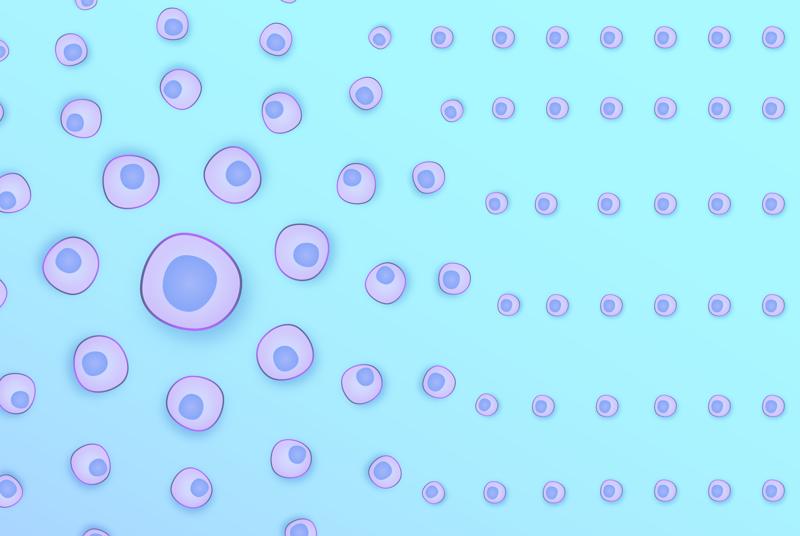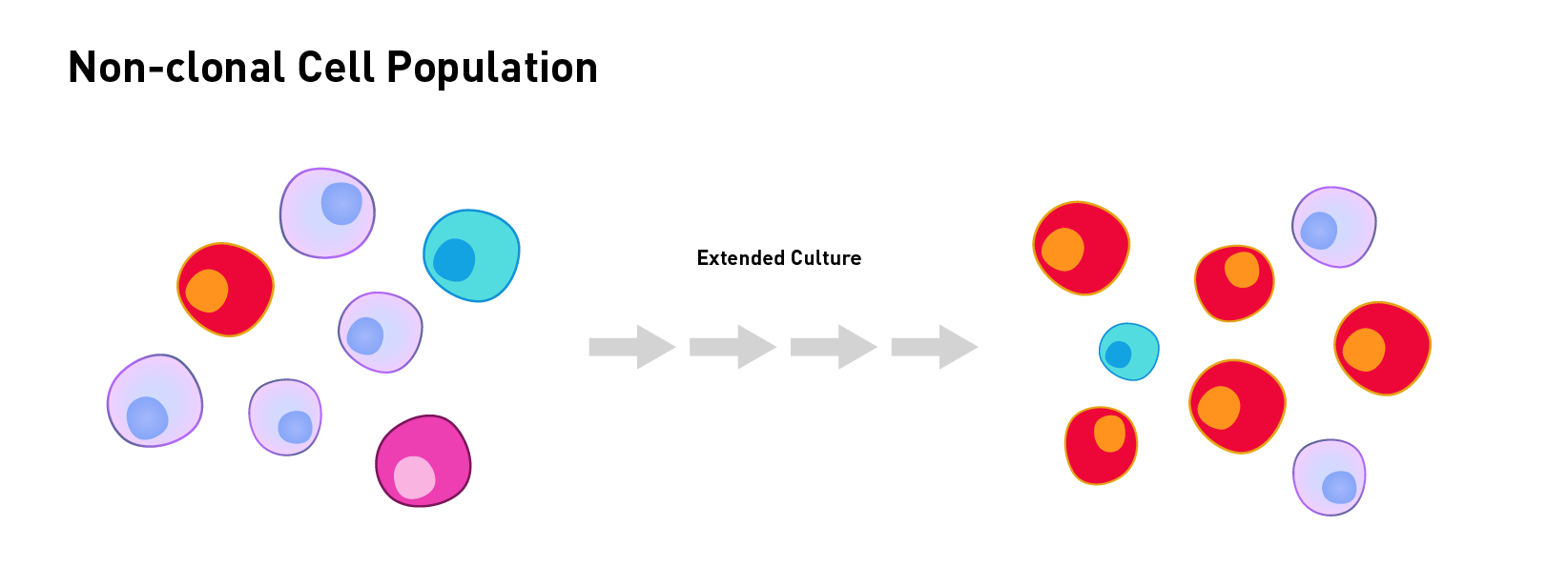Why Clonal iPSC Lines Are Essential: Building a Foundation for Reliable and Reproducible Research

Induced pluripotent stem cells (iPSCs) have become indispensable tools in modern biomedical research and are transforming how we model human disease, discover drugs, and explore regenerative therapies.
However, not all iPSC lines are created equally. One critical, but often overlooked factor that can impact experimental outcomes is clonality: whether an iPSC line is clonal or non-clonal. Clonality affects genetic uniformity, reproducibility, and the interpretability of downstream results. To address this and support greater precision in biomedical research, The Jackson Laboratory offers a large collection of engineered human iPSC lines for disease modeling and therapeutic discovery.
In this blog post, we’ll dive into what clonal iPSC lines are, explore their key advantages, and explain why they are essential for increasing the reliability and precision of biomedical research.
What Are Clonal iPSC Lines?
To start, let’s contrast clonal lines with non-clonal ones. A non-clonal line originates from multiple reprogrammed somatic cells, resulting in a genetically and epigenetically heterogeneous, or mixed, population. This diversity can lead to inconsistent experimental outcomes, misleading genotype-phenotype correlations, and often requires larger sample sizes to be statistically powered.
In contrast, a clonal iPSC line originates from a single reprogrammed cell, creating a population of genetically identical cells. This uniformity reduces variability within groups, minimizes confounding factors, and enhances reproducibility. With clonal lines, researchers often require smaller sample sizes and can achieve more reliable results, which is particularly important for high-throughput applications where consistent behavior across large-scale screens is critical.
For experiments that require reproducibility and consistent outcomes, clonal iPSC lines offer a clear advantage. In the following sections, we’ll explore the specific benefits of using clonal lines in various types of research.
The Advantage of Clonal Lines
Even within a single individual, cells may exhibit somatic genetic variability.1,2 During the reprogramming of donor cells into a pluripotent state, additional genetic and epigenetic heterogeneity can be introduced, compounding the initial cellular variability.3,4 Moreover, prolonged in vitro culture can result in culture-induced selection, leading to additional genetic variation over time.5 Studies have shown that individual clones derived from the same donor may differ in genomic integrity, transcriptional profiles, proliferative capacity, and potential for lineage-specific differentiation.
One significant advantage of using clonal iPSC lines is the elimination of such variability, resulting in a more uniform and reproducible cell population for downstream applications. This consistency allows for greater control over experimental variables from the outset.
When to Use Clonal iPSCs
1. Gene Editing and Precision Disease Modeling
Clonal iPSC lines are critical for genome editing experiments, as they provide a well-defined genetic baseline in parental lines and minimize variability in editing outcomes.
However, after editing, researchers need to ensure that the intended edit is present uniformly across the cell population. While homozygous edits are generally easier to validate, identifying truly heterozygous clones is more challenging. What may appear to be a heterozygous line could be a mixture of wild-type and homozygous cells. To address this, researchers must employ robust subcloning and/or genotyping strategies to confirm true heterozygous clones.
2. Drug Discovery and Screening
In drug development, reproducibility is everything. Clonal iPSC lines offer consistent cellular responses to therapeutics, allowing researchers to assess drug efficacy and toxicity with greater accuracy, reducing the chances of false positives or missed signals. This not only streamlines preclinical research but also reduces the risk of costly failures downstream.
3. Regenerative Medicine and Cell Therapies
Safety is paramount in regenerative medicine and cell therapy. Utilizing clonal iPSC lines that have been thoroughly screened for mutations helps mitigate the risk of genetic abnormalities that could lead to tumorigenesis in a subpopulation of cells. In this context, a deep understanding of clonal dynamics is essential for the development of safe and effective therapeutic strategies.
Maintaining Clonal Stability Over Time
It is important to recognize that clonal iPSC lines are susceptible to genetic changes over time. Extended culture can result in the accumulation of mutations in a subpopulation of cells that may gain a growth advantage and overtake the culture. To maintain reproducibility and reliability, researchers should prioritize iPSC lines that are not only clonal but also stable during extended culture and after genetic manipulation, like the KOLF2.1J and KOLF2.2J clonal lines.

JAX iPSC Platforms: Consistency, Stability, and Quality Assured
At The Jackson Laboratory, our genetically engineered iPSC lines are purpose-built to model disease-relevant mutations with fidelity and confidence. They are:
Derived from a extensively characterized clonal parental line (KOLF2.1J) that maintains genetic stability for over 25 passages6
‘Scarlessly’ engineered with CRISPR-Cas technology and rigorously quality-controlled to confirm the intended mutation is present, while excluding both off and on-target effects7
Validated using stringent subcloning and/or genotyping methods to confirm clonal purity
Screened by karyotyping, with SNP array results compared to parental DNA to ensure genetic integrity
Complemented with a revertant control to maximize confidence that the observed phenotype is directly attributable to the mutation itself
Peer-reviewed and validated for efficacy in differentiation assays, disease modeling, and drug screening6
Conclusion
Clonal iPSC lines are more than a technical refinement - they are a foundation for reliable, reproducible, and safe science. Whether you're investigating the cellular basis of disease, screening new drugs, or developing cell-based therapies, starting with a clonal line ensures that your results are grounded in biological fidelity. As the field of stem cell research continues to grow, so too should the emphasis on clonal integrity. It's a small step in protocol, but a giant leap for scientific rigor.
Explore JAX’s clonal iPSC Collection to find the right model for your next breakthrough.
Footnotes
Lo Sardo V et al. Nat Biotechnol. 2017;35(1):69–74.
https://pubmed.ncbi.nlm.nih.gov/27941802/Rouhani FJ et al. Nat Genet. 2022;54(9):1406–1416.
https://www.nature.com/articles/s41588-022-01147-3Gore A et al. Nature. 2011;471(7336):63–67.
https://pubmed.ncbi.nlm.nih.gov/21368825/Bar S, Benvenisty N. EMBO J. 2019;38(12):e101033.
https://pubmed.ncbi.nlm.nih.gov/31088843/Merkle FT et al. Nature. 2017;545:229–233.
https://pubmed.ncbi.nlm.nih.gov/28445466/Pantazis CB et al. Cell Stem Cell. 2022;29(12):1685–1702.
https://pubmed.ncbi.nlm.nih.gov/36459969/Skarnes WC et al. Methods. 2019 Jul 15:164-165:18-28.
https://pubmed.ncbi.nlm.nih.gov/31216442/